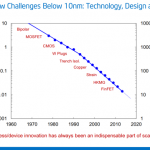 This week at the 2015 International Solid-State Circuits Conference (ISSCC), Intel will provide an update on its new 10nm manufacturing process and new research on how it’s maintaining the march of Moore’s law to 7nm and beyond. The first chips based on Intel’s new 10nm process are expected in late 2016/early 2017, and the company says it’s hoping to avoid the delays that haunted the belabored release of 14nm Broadwell. To hit 7nm, Intel says new materials will be required—as in, it looks like 10nm will finally be the end of the road for silicon. The most likely replacement for silicon is a III-V semiconductor such as indium gallium arsenide (InGaAs), though Intel hasn’t provided any specific details yet. ISSCC 2015, being held in San Francisco this week, is where all the big players in silicon (Intel, Samsung, TSMC, IBM, etc.) meet to talk about their latest manufacturing processes and how they might go about overcoming the current barriers to smaller, faster, and denser computer chips. It’s not unusual for Intel to have one of the largest presences at the conference, and this year is no different: it will be presenting three papers on its 14nm technology, hosting sessions on a variety of topics, and Mark Bohr—one of Intel’s most esteemed researchers—will be sitting on a panel that discusses Moore’s law beyond 10nm. The steady march of new CMOS processes driving ever smaller transistors. Intel Read 4 remaining paragraphs | Comments
This week at the 2015 International Solid-State Circuits Conference (ISSCC), Intel will provide an update on its new 10nm manufacturing process and new research on how it’s maintaining the march of Moore’s law to 7nm and beyond. The first chips based on Intel’s new 10nm process are expected in late 2016/early 2017, and the company says it’s hoping to avoid the delays that haunted the belabored release of 14nm Broadwell. To hit 7nm, Intel says new materials will be required—as in, it looks like 10nm will finally be the end of the road for silicon. The most likely replacement for silicon is a III-V semiconductor such as indium gallium arsenide (InGaAs), though Intel hasn’t provided any specific details yet. ISSCC 2015, being held in San Francisco this week, is where all the big players in silicon (Intel, Samsung, TSMC, IBM, etc.) meet to talk about their latest manufacturing processes and how they might go about overcoming the current barriers to smaller, faster, and denser computer chips. It’s not unusual for Intel to have one of the largest presences at the conference, and this year is no different: it will be presenting three papers on its 14nm technology, hosting sessions on a variety of topics, and Mark Bohr—one of Intel’s most esteemed researchers—will be sitting on a panel that discusses Moore’s law beyond 10nm. The steady march of new CMOS processes driving ever smaller transistors. Intel Read 4 remaining paragraphs | Comments
Taken from:
Intel forges ahead to 10nm, will move away from silicon at 7nm





